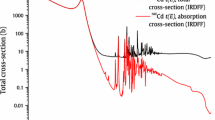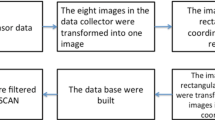Abstract
We report on the use of Maximum Entropy (MaxEnt) and Bayesian methods applied to problems in neutron scattering at Los Alamos over the past year. Although the first applications were straight-forward deconvolutions, the work has been extended to make routine use of multi-channel entropy to additionally determine (broad) unknown backgrounds. A more exotic example of the use of MaxEnt involves the study of aggregation in a biological sample using Fourier-like data from small angle neutron scattering. We have also been considering the question of how to optimise instrumental hardware, leading to the derivation of better “figures-of-merit” for spectrometers and moderators, which may result in a far-reaching revision of ideas on the design of neutron scattering facilities.
Access this chapter
Tax calculation will be finalised at checkout
Purchases are for personal use only
Preview
Unable to display preview. Download preview PDF.
Similar content being viewed by others
References
Bacon, G.E. (1955)Neutron Diffraction, Oxford University Press (3rd edition, 1975).
Brockhouse, B.N., Abou-Helal, H.E., Hallman, E.D. (1967). Lattice Vibrations in Iron at 296 K, Solid State Communications, Vol. 5, 211–216, Pergamon Press Ltd., GB.
Day, D.H. & Sinclair, R.N. (1969). Neutron Moderator Assemblies for Pulsed Thermal Neutron Time-of-Flight Experiments, Nucl. Instr. Meth., 72, 237–253.
Hjelm, R.P., Thiyagarajan, P., Sivia, D.S., Lindner, P., Alken, H., Schwahn, D. (1989). Small-Angle Neutron Scattering From Aqueous Mixed Colloids of Lecithin and Bile Salts, Progress in Colloid and Surface Science 82 (in press).
Lynn, J.W. (1975). Temperature Dependence of Magnetic Excitations in Iron, Phys. Rev. B, 11, 2624–2637.
Mezei, F. & Vorderwisch, P. (1989). Spectroscopy With Asymmetric Resolution Functions: Resolution improvement by an on-line algorithm, Physica B, 156 and 157, 678.
Michaudon, A (1963). Reactor Science and Technology, Journal of Nuclear Energy A/B, 17, 165–186.
Newton, T.J. (1985). Blind Deconvolution and Related Topics, Ph.D. Thesis, Cambridge University.
Robinson, R.A., Pynn, R., Eckert, J. (1985). An improved Constant-Q Spectrometer for Pulsed Neutron Sources, Nucl. Instr. Meth., A 241. 312–324.
Skilling, J. & Gull, S.F. (1989). Bayesian Maximum Entropy Image Reconstruction, Proceedings of AMS-SIAM Summer School on Spatial Statistics and Imaging, ed A. Possolo (in press). Also in Maximum Entropy and Bayesian Methods: Cambridge 1988, ed. J. Skilling, Kluwer Academic Publishers.
Seeger, P.A., Hjelm, R.P., Nutter, M.J. (1989). The Low-Q Diffractometer at the Los Alamos Neutron Scattering Center, Mol. Cryst. Liq. Cryst. (in press).
Silver, R.N., Sivia, D.S., Pynn, R. (1989). Information Content of Lineshapes, International Collaboration on Advanced Neutron Sources X, Los Alamos, Institute of Physics, Conf. 97 (in press).
Sivia, D.S., Vorderwisch, P., Silver, R.N. (1989). Deconvolution of Data from the Filter Difference Spectrometer: From Hardware to Maximum Entropy, submitted to Nucl. Instr. Meth.
Sivia, D.S., Silver, R.N., Pynn, R. (1989). Optimization of Resolution Functions for Neutron Scattering, Nucl. Instr. Meth. (in press).
Taylor, A.D., Wood, E.J., Goldstone, J.A. & Eckert, J. (1984). Lineshape Analysis and Filter Difference Method for a High Intensity Time-of-Flight Inelastic, Neutron Scattering Spectrometer, Nucl. Instr. Meth., 221. 408–418.
Windsor, C. (1981). Pulsed Neutron Scattering, Taylor & Francis Ltd., London.
Yethiraj, M., Robinson, R.A., Sivia, D.S., Lynn, J.W., Mook, H.A. (1989). In preparation.
Author information
Authors and Affiliations
Editor information
Editors and Affiliations
Rights and permissions
Copyright information
© 1990 Kluwer Academic Publishers
About this chapter
Cite this chapter
Sivia, D.S. (1990). Applications of Maximum Entropy and Bayesian Methods in Neutron Scattering. In: Fougère, P.F. (eds) Maximum Entropy and Bayesian Methods. Fundamental Theories of Physics, vol 39. Springer, Dordrecht. https://doi.org/10.1007/978-94-009-0683-9_10
Download citation
DOI: https://doi.org/10.1007/978-94-009-0683-9_10
Publisher Name: Springer, Dordrecht
Print ISBN: 978-94-010-6792-8
Online ISBN: 978-94-009-0683-9
eBook Packages: Springer Book Archive




